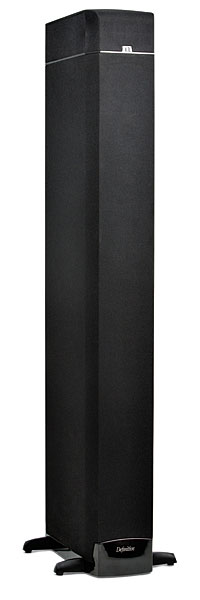Atmos, Here: Sound & Vision's First Foray Into Object-Based Sound

At home, this translates to a recommendation of ideally four additional speakers at the minimum: left/right “height” pairs, both front and rear, an arrangement Dolby refers to as 5.1.4 channels. A 5.1.2 layout, with front-position Dolby-enabled speakers (see below) or a pair of ceiling speakers to the left/right of the listening position, is also sanctioned. But 5.1.4 is said to be optimal and can be driven by a nine-channel receiver without requiring outside amplification. Atmos can also accommodate 7.1.4 and 9.1.2 layouts (with an 11-channel AVR) and could conceivably evolve to even more channels; remember, it’s scalable.
 While ceiling speakers are the obvious answer for new construction of dedicated home theaters and media rooms, most retrofitters are understandably reluctant to deploy the hole-saw overhead. Fortunately, Dolby and speaker-makers have cooked up a solution: upward-firing speaker modules, so-called “Dolby-enabled speakers,” sited atop the front left/right and surround speakers. Their up-firing drivers are angled such that their output—much of it, anyway—will reflect from a smooth, flat ceiling surface such as typical sheetrock or plaster, from roughly the same locations suggested by Dolby’s layout guides for ceiling speakers (which can now be found online at Dolby.com). These drivers can either be built into the top of a traditional box loudspeaker or added on with dedicated Dolby-enabled modules that rest atop an existing speaker.
While ceiling speakers are the obvious answer for new construction of dedicated home theaters and media rooms, most retrofitters are understandably reluctant to deploy the hole-saw overhead. Fortunately, Dolby and speaker-makers have cooked up a solution: upward-firing speaker modules, so-called “Dolby-enabled speakers,” sited atop the front left/right and surround speakers. Their up-firing drivers are angled such that their output—much of it, anyway—will reflect from a smooth, flat ceiling surface such as typical sheetrock or plaster, from roughly the same locations suggested by Dolby’s layout guides for ceiling speakers (which can now be found online at Dolby.com). These drivers can either be built into the top of a traditional box loudspeaker or added on with dedicated Dolby-enabled modules that rest atop an existing speaker.
To find out just how well this works, we rounded up one of the first—possibly the first—home theater Atmos systems: a Denon AVR-X5200 Atmos receiver and a quartet of Definitive Technology’s BP-8060ST powered towers ($999 each), each equipped with Def Tech’s new model A60 Atmos Elevation Module ($499/pair). These loaf-sized, up-firing cabinets cleverly snap into place atop the BP-8060STs, once each tower’s top panel is removed from its plastic “popper” pegs. It’s a damned slick system, and the end result looks exactly like it came from the factory that way. (Pioneer, Atlantic Technology, Integra, KEF, Onkyo, and Yamaha have also debuted Atmos-ready speakers or electronics, with more doubtless to follow.)
But since we also wanted to learn how adaptable Atmos might be, I tried the A60 modules in unsanctioned duty (sorry, Def Tech!) atop my long-term speakers: Energy Veritas three-way, stand-mount monitors up front and dipole surrounds in back. Making this work required nothing more exotic than a few temporary, stick-on rubber feet, from among the hundreds I’ve, err, collected from review samples over the years. I ended up dropping the front modules right on top of the Veritas mains and placing the “back” modules on the sidewall shelves, right alongside my existing dipole surrounds, at approximately 4 feet from the ceiling. The slanted baffles on the rear Atmos speakers fired toward the front of the room, angled slightly inward to mimic the angle they’d see if they’d been mounted on toed-in rear speakers.
Atmos-encoded programming will be available, initially at least, only via Blu-ray Disc, though some streaming sources should quickly follow. This limited our test material to Dolby’s August, 2014 Atmos Demonstration Disc, a collection of Atmos trailers, two movie scenes, and a music video. Late in the game, through the good offices of Paramount Home Media, I received a pre-release full copy of Transformers: Age of Extinction, announced as the very first Atmos title to be released to the wild.
Atmos Revealed
All this, of course, is merely preliminary to what you really want to know: Just how does Atmos, here and now, sound? Pretty damned good, is the short answer. My listening to the jury-rig over my own speakers quickly persuaded me that when you hear a properly set-up Atmos system for the first time, you won’t harbor much doubt as to the difference. I allowed the Denon’s excellent Audyssey Platinum/MultEQ XT32 to handle the setup, including the height speakers (but I confirmed channel levels manually).
The first trailer I auditioned from the Dolby disc was “Leaf,” a CGI point-of-view fly-through of an autumn forest, with swirling breezes, falling leaves, and a personified maple-seed-propeller (a spring thing, not an autumn one, but let’s not be pedantic) whirling around. This turned out to be a fortuitous choice, showing what I ultimately judged to be Atmos’ strengths to advantage. The clip opens with rustling leaves and birdsong; then wind noises whirl subtly but audibly overhead—not directly so as in “look up at the ceiling!”—but in a sort of flattened-hemisphere, impressively coherent bubble of surround. The whizzing maple seed did likewise, but in a much more tightly focused, localizable way. Individual birdsongs localized nicely at various three-quarter positions in three dimensions. But I was impressed not so much by any hard-hitting Atmos overhead-ness—though this certainly occurs—as by the enhancement of ambient textures: The forest-sound aural environment was an order of magnitude more convincing than any I’d previously heard from my system.

This is not to say overhead discrete effects aren’t dramatically more vertical. Dolby’s similar, live-photography “Amaze” trailer, which presents a rainforest environment with a flapping bird circling convincingly overhead, was equally impressive in its immersiveness and continuity. The bird flies not just overhead, but clearly around the periphery, such that the clip’s closing onscreen title, “Natural & Lifelike” seemed perfectly apt.
When I replayed these clips with regular, non-Atmos Dolby Surround—deactivating the height modules—they reverted to what I’m accustomed to hearing from my layout: a solid surround bubble, but a flat-topped one that exists mostly in two dimensions and is pinch-waisted from front to back. Atmos changed all this, opening out the middle and raising the roof, but most importantly, lending detail and air, and a subtly brighter overall timbre, to ambient effects. The difference, I would predict, might seem subtle or even elusive to casual listeners, but I think experienced surround-freaks will find it revelatory.
I was already a convert—and remember, this is with the A60 height modules mongrel-ated onto my own speakers. With Def Tech’s slim, bipolar towers in all four corners according to the geometry set out in Dolby’s online setup guide, I topped each with an A60 module clipped neatly into place.
The difference was surprisingly small. Definitive’s BP-8060STs are very balanced speakers, so their overall presentation is not at all dissimilar to my everyday setup. (See my original review of the BP-8060STs from 2011 and keep an eye out for an update.) They are bipoles, however, and so sound rather more diffuse; but in Atmos mode, this made comparatively little difference. The main distinction I heard was that the rear surrounds, and thus rear height modules, being a couple of feet lower and a couple closer to the listening position, seemed a little more easily localizable—although Atmos mode distinctly lessened this tendency as compared with straight 5.1. Otherwise, I felt that the net Atmos effect was very comparable, so much so that in the absence of a direct A-B (which obviously was not possible), I could not differentiate any change in the Atmos effect from that of changed main speakers. From this, I infer that “timbre-matching” of the height-module speaker may well be fairly non-critical, though directivity may matter a good deal.
Our demo disc, intended for manufacturer show demos, includes a couple of audio-only on/off clips that toggle between Atmos and 5.1 (no height-module signals) modes. One, “Storm,” of a thunderstorm, was the most demonstrative: When toggling to 5.1, the sounds of raindrops falling onto overhead leaves (presumably; there’s no video) tended to slide forward, into a flattened plane slanting above and out from the front stage, then back to full-dome when Atmos returned.
The remaining Dolby disc’s nine or so clips and trailers all tended to confirm these observations; space does not permit discussing them individually. The Transformers disc provided an opportunity to examine Atmos in the context of a longer listening/viewing experience. Many of the film’s Atmos-pherics were of the whiz-bang sort: towering robots whirring, grinding, and smashing, which Atmos dutifully rendered in an obviously more three-dimensional fashion. A scene like the mini-drones and helicopters in chapter 3 (Atmos was made for the helos!) ably showed off what the new technology can do, as whizzing drones and over-flying ’copters were impressively mobile.
One interesting note: Noisy, bright movies like Age of Extinction tend to make me grope for my processor’s treble-taming Re-EQ mode or equivalent; Denon’s Cinema EQ imposes a mild down-tilt over the uppermost two octaves or so, no more than perhaps 4 decibels at 20 kilohertz (and much less at 10 kHz). As the gnashing of machines and blowing-up of stuff ground on, my ears thanked Cinema EQ again and again—but the Atmos effects seemed slightly less pronounced with this feature turned on; flyovers/-arounds were a bit less dramatic and the ambient bubble less distinct and one-piece. From this, I suppose that Cinema EQ is applied to all channels including the height outputs (red-face me if I’m wrong). Since the height modules must bounce off of a reflective ceiling, and reflectivity of sound increases with frequency, less high-frequency content will mean fewer reflections.
The whole Atmos-enable height-module thing worked much better, frankly, than I expected. I never really found my ear being drawn to the modules themselves, which surprised me. And Atmos’ enhancement of naturalistic ambience and acoustic space—which, honestly, is what I value about surround-sound, above explosions and fly-bys—made me hungry for more.
Atmos, here? Yes, please.
MORE FROM S&V's DOLBY ATMOS SPECIAL
Interview: Greg P. Russell, sound rerecording mixer of Transformers: Age of Extinction




























































